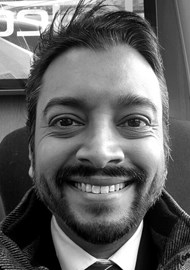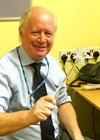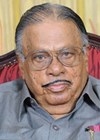On the occasion of his retirement from the Nottingham Auditory Implant Programme, we discuss his pioneering work in cochlear implantation and the challenges involved.

ENT News author picture, 1993.
Why did you choose a career in ENT?
I started off doing general surgery and it was fairly common at that time to rotate through the general surgical kind of specialties, but I was always attracted by the microsurgery of ENT and endoscopic work, as well as the diversity within ENT.
Was it ENT as a speciality as a whole that appealed to you or was it specifically otology?
ENT was attractive because the whole package seemed quite challenging. I was initially just as interested in rhinology and laryngology, and of course one still has to train in the totality of the specialty. So the interest in otology and audiology emerged with the passage of time.
How did you then fall into the research side of things?
That could be attributed to the Thomas Wicken Jones Foundation and the TWJ Fellowships, which were and still are available to ENT senior registrars. I got a TWJ Fellowship to the University of California in San Francisco in the Coleman Lab, which was a neurophysiology and neuroscience lab. It was very well known in the field of hearing research, in particular brain mapping and inferior colliculus work. When I arrived in the lab, I didn’t know much about neuroscience, but the head of the lab Michael Merzenich took me under his wing. He was an excellent mentor and got me involved in various projects, especially in relation to cochlear implantation.
It seems great strides were being made in cochlear implantation in America. What was the situation in the UK at that time?
In comparison we were well behind the curve. There was no cochlear implant programme in the UK at the time. Possibly there were the beginnings of a programme at UCL and at Guys, but not a clinical programme as we know them today. Even in the United States, it was still very early days as it was still of unproven value – that only emerged with time.
Michael Merzenich was the first person to take cochlear implants seriously and invested in them intellectually. I believe he was the first to get an NIH grant that enabled him to study cochlear implants. Without Merzenich and the NIH involvement at that time, that clinical progress for cochlear implantation would have been delayed by many years.

Gerry O’Donoghue organises the Molecular Genetics in Hearing Impairment Course at RSM, 1993.

Cochlear implantation in under twos, Ear Foundation 10th Anniversary, 29 October 1999, Nottingham, UK (Gerry, back centre).
At what point do you think the basic sciences community and the wider ENT global community realised that cochlear implants were a groundbreaking neuroprosthesis?
Initially of course, the implants were extracochlear, where the electrodes were placed on the promontory and speech understanding was poor. Then House in Los Angeles dared to go intracochlear. There was a worry of going into the cochlea because of the fear of meningitis and so there was a reluctance on the part of otologists at the time to actually enter the labyrinth. William House developed a single-channel electrode that went into the cochlea for only for four or five millimetres, and found he could get some very limited speech understanding. Colleagues in San Francisco then went multichannel intracochlear – a longer electrode with different site stimulation – and they were getting speech understanding through the device for the first time.
Let me put a controversial question to you. If cochlear implants were being researched today, do you think we would have more barriers?
For certain. During the 70s and early 80s there was not as much regulation. Today one could argue that novel research is almost overregulated. Dr William House was perhaps the greatest clinical pioneer of cochlear implantation. What he was able to do at that time, he could not have done a decade later. And we were very lucky that he was able to study the effects of cochlear implantation in humans. He did it safely and competently, but he wasn’t shackled by the administrative and legal burdens that we have today doing human research.

Reudi Lecture 2000 and International Workshop on the Aretic ear. (L–R):
Thomas Reudi (son of Luzius Reudi), Gerry O’Donoghue, Ugo Fisch and Gregorio Babighian.

Hearing Loss 2003, 28–31 August 2003, Athens, Greece. Profs Huttenbrink, Ramsden, Stamataki and O’Donoghue.

2nd Cochlear implany group of India (CIGI), 29–31 October 2004, Chennai India.
Gerry O’Donoghue receiving the CIGI citation from Prof Rajasekharan, President, National Board of Exams.

Conference on Deaf Children Paves the Way for European Collaboration, 13–14 May 2005, London, UK. John Low, Vladimir Spidla, Gerry O’Donoghue.
What advice would you have for clinician researchers today in terms of striking that balance between overegulation and stopping rogue science getting from the bench to the bedside, taking the Macchiarini affair as a prime example?
It’s an important question. Protecting patients has got to be the primary concern when undertaking human research. As you mention, there have been some terrible instances of research abuse and where patients were actually hurt in research. And that’s unforgivable – too high a price to pay for progress. So I think we have to live and work with the regulation, engaging with regulators to facilitate our work. We, as clinicians, have got to be smarter to understand the regulatory framework within which we practise, which you cannot shortcut. Protecting patients I think is key and patients must feel safe in the research environment.
After your fellowships in the US, you came back to the UK and took a consultant post?
I was working in Oxford at the time and the position came up in Nottingham in 1988, with the Medical Research Council’s Institute of Hearing Research. It was a great opportunity to combine research with clinical work. I was also very interested in skull base work after my time in the States, so to combine that with my otology practice and having a neurosurgery unit as well was very attractive. So it was the perfect opportunity to combine the research, do the neurotologic surgery and, in time, set up the cochlear implant programme and take that forward.

The Ear Foundation Bilateral Implantation Meeting, March 2007. Rich Tyler and Gerry O’Donoghue.

CIGICON, November 2008, Bangalore, India. Sunil Dutt and Gerry O’Donoghue.

Prof Gerry O’Donoghue, RSM Otology Section President, with the presenters at the Dragon’s Den event, 2014. (L–R): Back row: Gerry O’Donoghue, Vik Veer, Alex Yao, Natalie Hopka, Tony Narula, Matt Clark, Emma Stapleton, Krishan Ramdoo, Chris Coulson. Front row: The Dragons: Jim Roberts, B Sethia, Richard Ramsden, Tony Young.

IFOS Paris, 24–28 June 2017. Gerry congratulating Shahed Quraishi, his former registrar.
You were the driving force in getting the implant programme going here in Nottingham. What were the challenges you faced?
When I came to Nottingham on the back of my experiences in the USA, there was absolutely no question on the necessity of having a cochlear implant programme here. Initially it wasn’t funded through the NHS, and so the only way was to set up a charity. We called it the Ear Foundation and that’s how we raised a substantial amount of money for the first 10 implants or so. The results from those very early implants were sufficient to convince the NHS of the safety and emerging effectiveness of the procedure, so that it was seen as a technology worth evaluating. From that point onwards it was available through the health service with fairly strict audiological criteria: the patient had to be totally deaf to merit implantation. There was no question of having residual hearing as is the case today.
What resistance did you face from colleagues in the ENT world?
The acceptance of cochlear implantation was difficult for some colleagues because they could not believe that a small number of wires in the cochlea could replace thousands of hair cells. How could we be so naive as to think that that would be possible? And the question of meningitis was always there because we’re putting a long electrode into the cochlea. Children get otitis media and the fear was that the electrode would act as a conduit for the spread of infection from the middle ear to the meninges. We now understand the importance of vaccination, especially pneumococcal vaccination in children who are about to have cochlear implantation. That was a lesson that we learned along the way and it was a painful lesson. Once we saw these sporadic cases (of meningitis) we acted very quickly. We did a large epidemiological study here in the UK so we could identify the scale of the problem and we were able to recommend vaccination quite early.
Many colleagues, particularly senior figures in the specialty, felt the scientific basis was not sufficient and that cochlear implantation was not the way forward: it was unsafe and it was experimenting with deaf people. Electrical stimulation of the auditory system had a long history right back to Volta, and he didn’t have a very happy experience with electrical stimulation, which has permeated the literature since. So it was always viewed with some scepticism.
When we started formally launching a clinical programme, it upset colleagues who felt very strongly that this was neither the time nor the place to start a programme.

Current Trends in Implantation Otology, 7–8 September 2023, Dublin, Ireland. (L–R):
Profs Gerry O’Donoghue, Quentin Summerfield and Erwin Offeciers.

Nottingham Auditory Implant Programme (NAIP) thank-you cake presentation, May 2024.
Your experiences seem familiar to me from when I conducted my own PhD research in stem cell therapies, which you were instrumental in facilitating. We are now at a situation where we’re going to be doing first in-man trials for cell-based therapies for deafness. So the scepticism people may have about biological therapies is a path you have trodden before with implants!
Absolutely. I think if you’re going to make a step change in any field, you can expect opposition. Its inevitable that you will upset certain individuals who have very fixed views on treatments and see that a new intervention might displace the accepted order of things. I think if you go through your career without facing opposition, you’re probably not at the forefront of innovation.
Looking back over your years in research, do you think there’s anything you could have done differently – or wish you could have done?
Oh, I wish I could have spent longer in basic research! I didn’t work to a PhD level in research. Three years at the University of California in San Francisco would have been great, but I was there for less than a year. It probably wasn’t enough time to make the big mark that I would have liked to. So, if I had my time again, I’d be doing more fundamental research for longer in my training. But I wouldn’t want research to compromise my clinical work, of course.

Gerry with his colleagues Priya Achar and Tawakir Kamani.
What’s been the highest point for you in your research career?
Seeing the first patients from our programme have their first ‘switch-ons’ and especially children hearing their parents’ voices for the first time. I’ve seen hundreds, perhaps even thousands now, but it’s still extraordinary to be able to replace such a vital sensory organ, not perfectly, but to do it so meaningfully is really quite special – miraculous, I would say.
What advice would you have for trainees as they embark upon a career, aspiring to be a high-achieving clinician such as yourself? I ask this as many trainees can reach periods of disillusionment, and one of the things I always experienced whenever I came to you for advice was that I came away feeling more positive about my academic and surgical career.
I think having a good mentor is very important – whether in your own or another department – somebody you can connect with. I would also say that the hardest glass ceilings to break through are those that we give ourselves. We convince ourselves that we are not researchers or we’re not good at technology or we’re not good at a particular task, or we don’t see ourselves as advancing the field. We must move way from this mindset. I think they should be ambitious for themselves and not be blown off course by early failure or disappointment.
Anybody who has been through all the selection procedures to get into specialty training is certainly bright and competent enough to do what they want to do in any discipline they choose.
Be all you can be and, certainly in today’s world and today’s medicine, you can have connectivity with people around the world. You don’t even have to have connections in your own department to do good work, both in research and in the clinical world. Be ambitious and don’t take no for an answer.

Current Trends in Implantation Otology, 7–8 September 2023, Outside of O’Donoghue pub, Dublin, Ireland.
What final words could you give to your consultant colleagues here at Queen’s Medical Centre?
I’ve seen the evolution in Queen’s Medical Centre over the years and it’s been phenomenal. Its progress isn’t always easy or linear, it often takes time and one has to be patient to affect change. One also has to recognise the talents of others. In a department like ours, you need people with many talents, many mindsets. I think it’s a department that can encompass people with very divergent views who can still work together for the benefit of the service as a whole. As I leave the department, I look around at the people here and I’m hugely impressed by their individual strengths and how well they work collectively to see the department move forward and address the service needs of today. At the same time they’re doing some very elegant research that will be important to our field. So, I’m very proud of the department that I’m leaving behind and also very hopeful – I will be expecting great things from the department in the future.








































